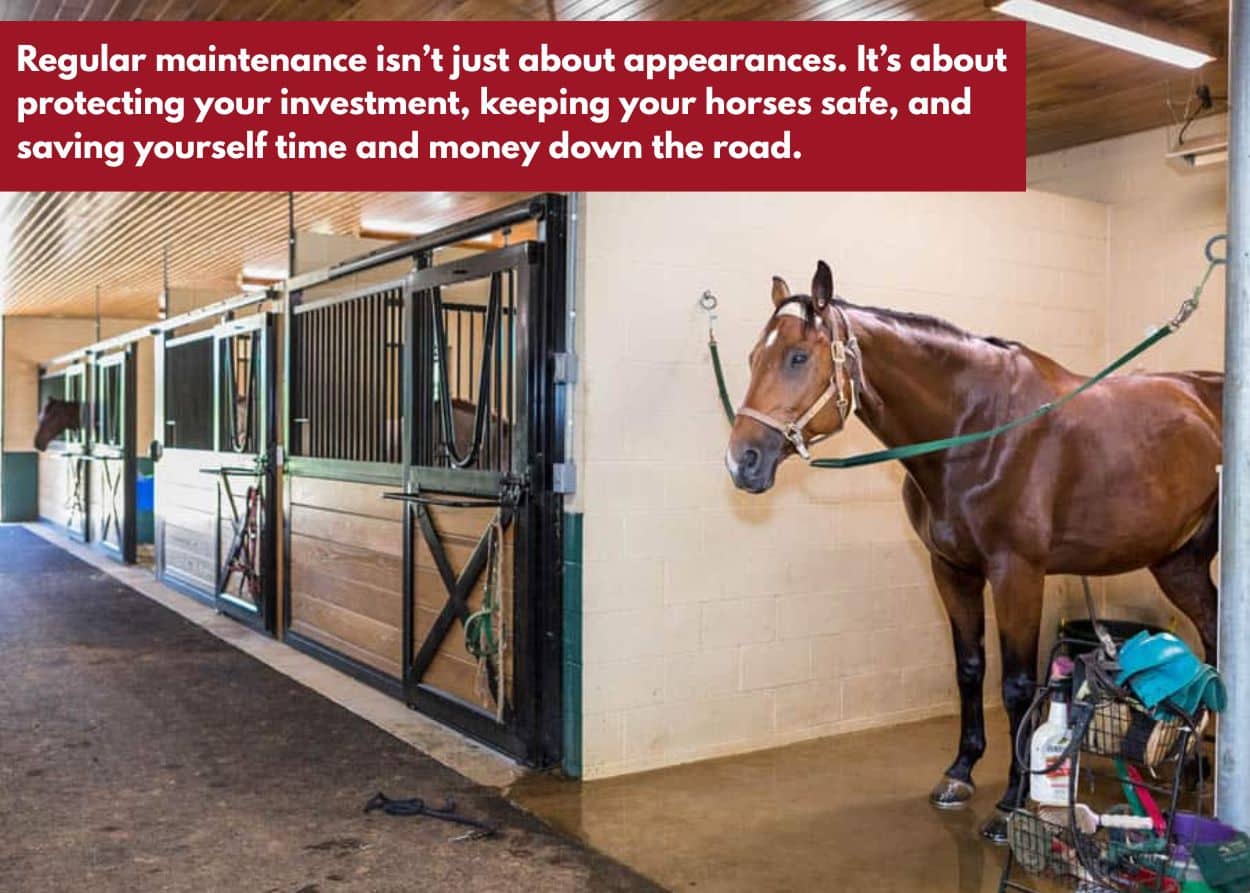Horse Barn Maintenance Checklist: Monthly & Seasonal Tips for a Safer, Longer-Lasting Barn
Table of Contents:
You’ve invested a lot in your horse barn.
Time. Money. Sweat. Maybe even a few midnight repairs you don’t want to talk about.
But here’s the thing: even the strongest, best-built barn won’t stay that way without regular care. Wood warps. Moisture creeps in. Rodents chew wires. One loose board or bad outlet can quickly become a major safety hazard—for you and your horses.
That’s where maintenance comes in.
And the good news? It doesn’t have to be overwhelming. With a simple monthly checklist and a few seasonal habits, you can keep your barn safe, clean, and running smoothly all year long.
At Tristate Barn Builders, we know the value of a well-kept facility. We've helped horse owners and farm managers across the tri-state region build barns that last—and we’re here to help you take care of yours, too.
In this post, we’ll walk you through a practical monthly barn maintenance checklist, plus season-by-season tips to make sure your investment stays strong.
Ready? Let’s get to work.
Monthly Horse Barn Maintenance Checklist
Consistency is key. A little bit of attention each month can prevent expensive repairs down the road—and protect your horses from injury or illness. Here’s what to include in your monthly barn walkthrough:
1. Structural Inspection
Start with the bones of your barn.
- Look over support beams, posts, trusses, and siding for signs of rot, warping, or cracks.
- Pay attention to doors and gates—do they open smoothly? Sagging hinges or sticking latches could signal a deeper issue.
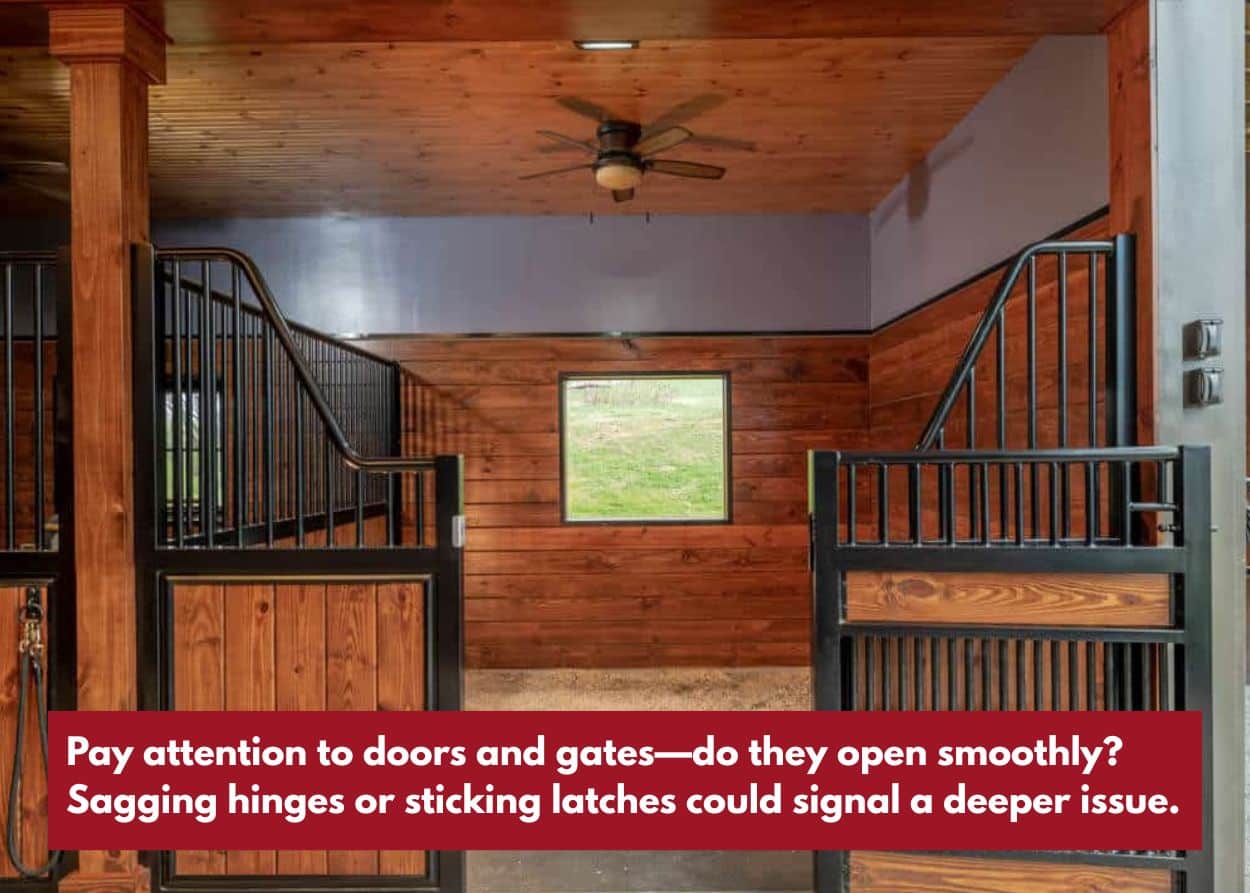
- Check the roof for loose or missing shingles, rusted screws, or any light peeking through. Even a small leak can lead to big problems.
Think of this like your barn’s routine check-up. Small issues caught early are a whole lot easier to fix.
2. Ventilation & Air Quality
Good airflow isn’t a luxury—it’s essential for your horse’s respiratory health.
- Clean vents, ridge caps, and louvers to prevent dust buildup.
- Inspect exhaust fans and circulation fans. Replace worn belts, clean blades, and test that they’re working properly.
- Sweep or blow out cobwebs, dust on ledges, and hay dust that settles in corners.
When the air stays fresh, your horses stay healthier. And your barn smells a whole lot better.
3. Flooring & Drainage
Wet or uneven flooring? Major hazard.
- Check stall mats for curling edges, deep cracks, or shifting that creates gaps.
- Pull up mats every few months to inspect for trapped moisture or mold underneath.
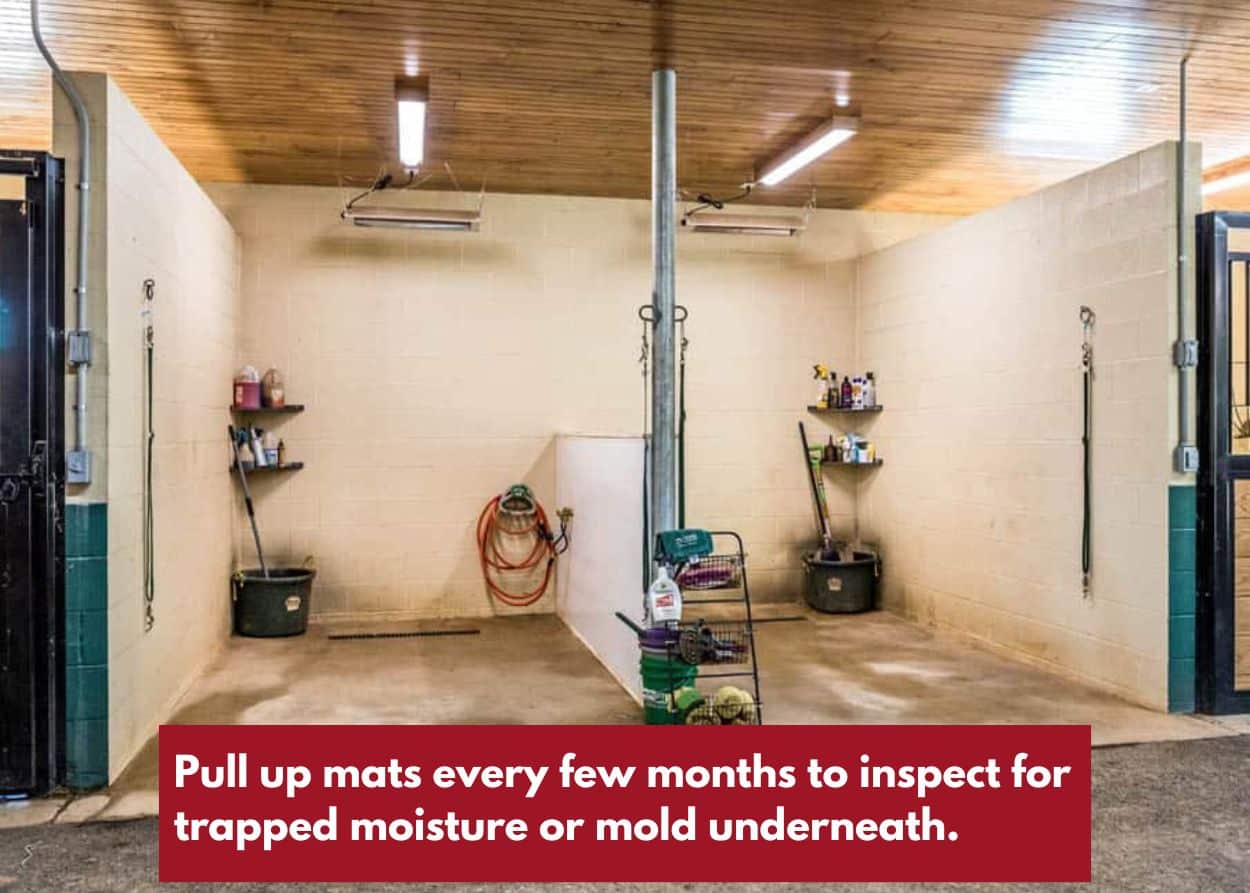
- Walk your aisles after a heavy rain. Are there pools of water? If so, drainage needs work—whether it’s clogged trenches or low spots in concrete.
Dry floors = safer footing and fewer bacteria.
4. Electrical & Lighting
Electrical issues are one of the most common causes of barn fires. Don’t skip this.
- Test outlets, switches, and breakers monthly.
- Look for signs of rodent damage—chewed wires, frayed insulation, or nesting near electrical boxes.
- Replace burned-out lightbulbs and check that all exterior lights work properly (especially as days get shorter in winter).
If something sparks or smells “off,” get it checked. Fast.
5. Plumbing & Water Systems
Horses drink a lot of water. So your plumbing needs to keep up.
- Inspect hoses, faucets, and auto-waterers for leaks, cracks, or mineral buildup.
- Make sure valves shut off properly and there’s no drip-drip-drip wasting water (and money).
- Clean water buckets and troughs regularly to prevent algae or bacterial slime.
Clean water isn’t just good for your horses—it’s good for your peace of mind.
6. Safety Equipment Review
Emergencies don’t wait until your barn is “ready.”
- Confirm all fire extinguishers are charged and accessible.
- Restock first-aid kits—both human and equine.
- Keep exit paths and aisles clear of clutter or blocked gates.
You hope you never need this stuff. But if you do… you’ll be glad you checked.
7. Cleaning & Pest Control
Clean barns are happy barns.
Schedule a monthly deep clean: muck stalls, power wash mats, disinfect walls, sweep cobwebs.
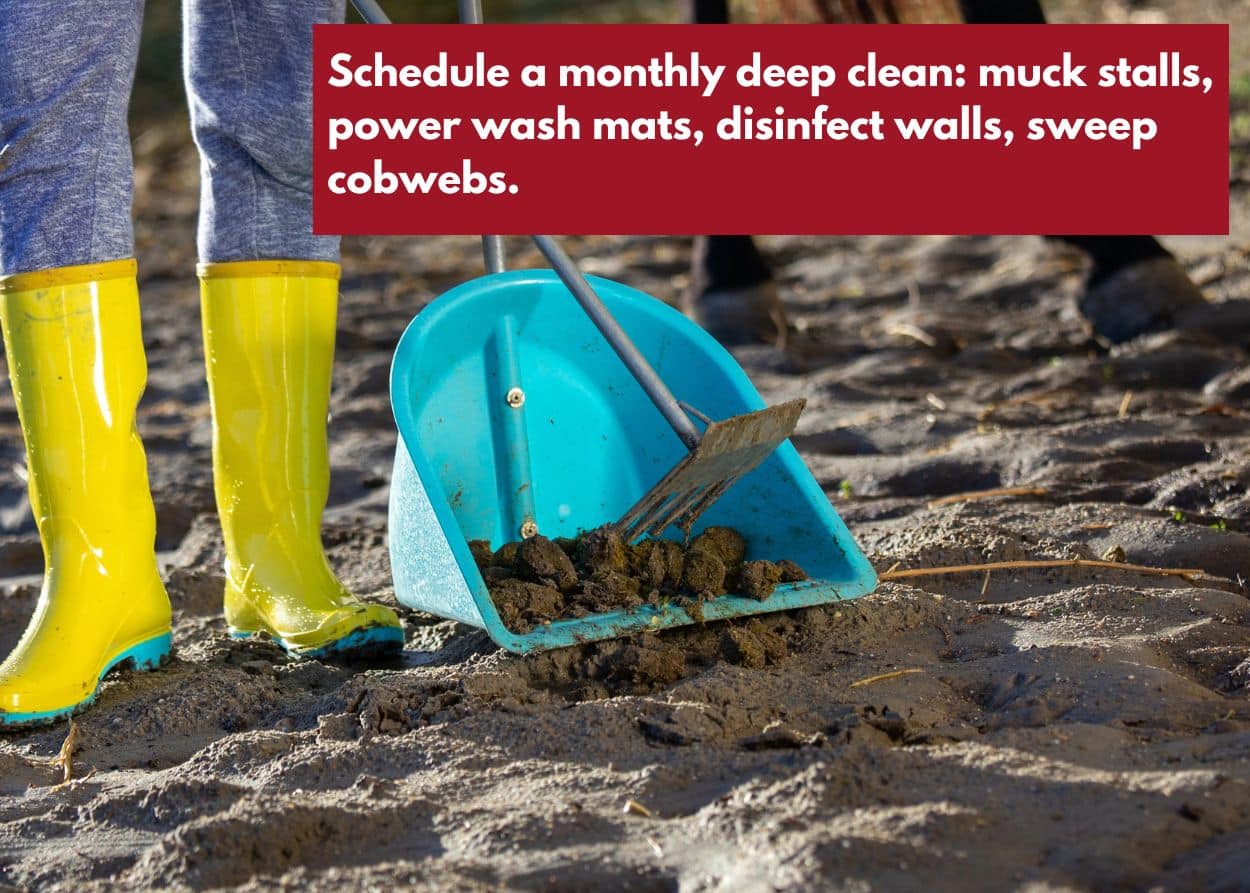
- Check for signs of rodents or insects—droppings, nests, chew marks, or odd smells.
- Store feed in sealed containers and rotate bait stations or traps as needed.
A clean barn not only smells better—it keeps horses healthier and pests away.
Seasonal Horse Barn Maintenance Tips
While your monthly checklist covers the basics, each season brings its own set of challenges. Think of these seasonal routines as your barn’s “deep clean” and tune-up—keeping things running smoothly no matter what the weather throws your way.
Spring
Winter’s over… but it usually leaves a mess behind.
- Clear debris: Sweep out cobwebs, clean gutters, and remove leaves or hay that have collected in corners.
- Inspect the roof and siding for any damage from snow, ice, or high winds.
- Check drainage systems: Make sure water flows away from the barn during spring rains.
- Get ahead on ventilation: Service fans and open up airflow before summer heat kicks in.
- Evaluate turnout areas for mud, erosion, or broken fencing.
Spring is your reset button. Clean up, fix what winter damaged, and prep for warmer weather.
Summer
The heat is on—and so are the bugs.
- Monitor humidity: Open up barns early in the day to reduce moisture and help air circulate.
- Clean water sources often to prevent algae and bacteria growth.
- Inspect shade structures and trees: Prune overhanging limbs and make sure horses have relief from the sun.
- Control flies and pests: Swap out traps, rotate repellents, and check for wasp nests around eaves.
- Look for signs of overheating in horses: heavy breathing, sweating, or lethargy.
Summer’s biggest threats? Heat stress, dehydration, and infestation. Stay ahead of them.
Fall
Time to winter-proof.
- Check seals around windows and doors—keep out drafts and pests.
- Inspect and insulate pipes to avoid freezing later on.
- Test barn heaters, heated buckets, or waterers before you need them.
- Deep clean feed rooms and prep bedding storage for the cold season.
- Trim vegetation near buildings to reduce fire risk and discourage nesting rodents.
Fall is your chance to prep for the long haul—don’t leave it to the first snowstorm.
Winter
Now it’s all about survival mode.
- Keep walkways clear of ice and snow—especially exits and emergency routes.
- Check for ice dams or heavy snow on the roof. Too much weight can be dangerous.
- Keep ventilation running even in the cold to control moisture and ammonia buildup.
- Monitor electrical systems under strain from heaters, lights, and waterers.
Watch for rodent activity—they love warm barns.
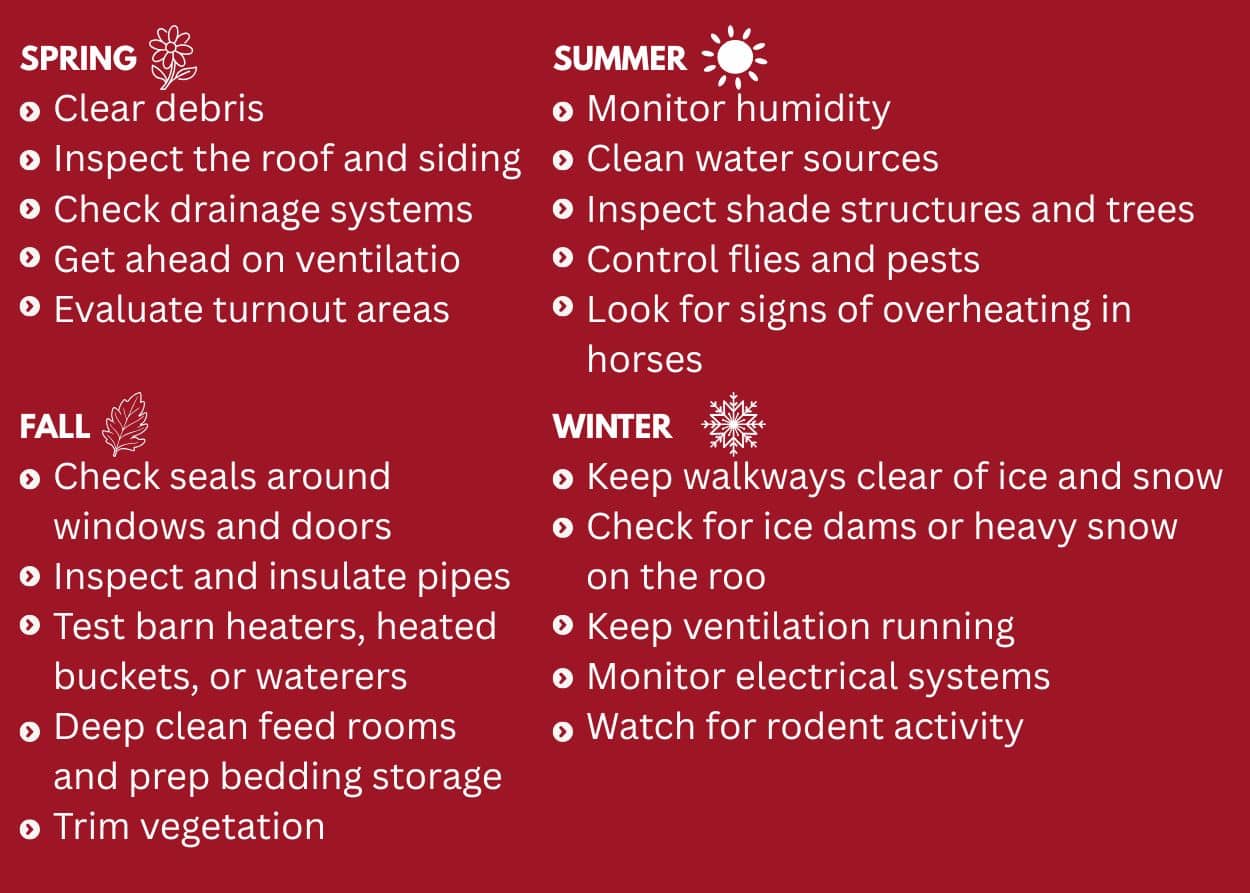
You’re not just maintaining comfort—you’re preventing freeze damage, illness, and injury.
A Safe Barn Is a Cared-For Barn
Here’s the truth: barns don’t take care of themselves.
And when you’re juggling horses, feed schedules, pasture rotations, and everything else—barn upkeep can fall to the bottom of the list.
But regular maintenance isn’t just about appearances. It’s about protecting your investment, keeping your horses safe, and saving yourself time and money down the road.
